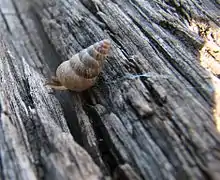Snail slime
Snail slime is a kind of mucus, an external bodily secretion, which is produced by snails, which are gastropod mollusks. Land snails and slugs both produce mucus, as does every other kind of gastropod, from marine, freshwater, and terrestrial habitats. The reproductive system of gastropods also produces mucus internally from special glands.

Externally, one kind of mucus is produced by the foot of the gastropod and is usually used for crawling. The other kind of external mucus has evolved to coat the external parts of the gastropod's body; in land species, this coating helps prevent desiccation of the exposed soft tissues. The foot mucus of a gastropod has some of the qualities of glue and some of the qualities of a lubricant, allowing land snails to crawl up vertical surfaces without falling off.[1]
The slime trail that a land gastropod leaves behind is often visible as a silvery track on surfaces such as stone or concrete.
Description
Mucus is a gel consisting of a polymer network that functions as a protective layer for the integument and mucosal surfaces of both elementary animals and mammals.[2]
The mucus of gastropods is not only used as a coating to cover the surfaces on which the snail crawls and a coating to cover the exposed soft parts of the body but also sometimes to allow a resting snail to adhere passively to surfaces, such as rock, making a temporary sealing structure called the epiphragm.[3] Mucus is produced by a large gland located below the snail's mouth.[4]
The foot of gastropods is covered with a thin layer of this mucus, which is used for a variety of functions, including locomotion, adherence, lubrication, repulsing predators, recognizing other snails, following a trail to a known destination and during reproduction. The discharge looks like a gel and it contains approximately 91 to 98% water by weight, depending on the species, combined with a small amount of high molecular weight glycoproteins (Denny, 1984). In Cornu aspersum, these glycoproteins reach weights of 82, 97 and 175 kDa.
.jpg.webp)
Land mollusks travel by adhesive locomotion via muscular waves that propagate from tail to head. The snail mucus has an adapted flow behavior that allows transmittance of the muscular force while maintaining adhesion.[5][6] When inactive, many mollusks of both marine and terrestrial species, use the secretion to stick to various surfaces. However, although it is so diluted that it can commonly act as a lubricant, it can also have strong adhesive properties.[7] In their unique mating ritual, Limax maximus use a mucus thread to suspend themselves from elevated locations like tree branches.[6] In Cornu aspersum, there are two types of secretion. One type is translucent and not adhesive, the kind that the snail leaves behind as it moves (the slime trail), and the other is similar but thicker, condensed, more viscous and elastic, which is used to adhere to various surfaces. Both are clearly differentiated by the type of proteins present in them.[8]
A snail releases different kinds of mucus depending on the way it is stimulated. When the stimulation is normal, the slime is viscous (sticky) but if the snail is disturbed continuously or even violently, it releases clear foamy secretions. If the snail is sexually aroused the slime it releases is clear and viscous (sticky). In the case of Cornu aspersum, the discharge is composed of synthesized products from various types of secretory glands. These are all single-cell glands found in connective tissue and they secrete their products via pores that pass between the epidermal cells. They are of various shapes and usually have a long excretory duct. There are eight different types of secreting glands. Four of these different types secrete protein, calcium, pigments and lipids.[9]

See also
References
- RSC Publishing - Substitutes_for_snail_slime.asp
- Verdugo, P., Deyrup-Olsen, I., Aitken, M., Villalon, M. and Johnson, D. (1987). Molecular mechanism of Mucin Secretion: The role of intragranular charge shielding. J Dent Res. 66 (2): 506-508
- Hickman, C., Roberts, L. and Larson, A. (2002). Principios integrales de Zoología. 11°. Ed. McGraw- Hill Interamericana. España. Pp 328, 329, 330, 333. 98 (Spanish translation)
- Ruppert E. E; Fox R.S. & Barnes R.D. 2004. Invertebrate zoology: a functional evolutionary approach. Belmont, CA: Thomas-Brooks/Cole.
- Ewoldt, Randy H.; Clasen, Christian; Hosoi, A. E.; McKinley, Gareth H. (2007). "Rheological fingerprinting of gastropod pedal mucus and synthetic complex fluids for biomimicking adhesive locomotion". Soft Matter. 3 (5): 634. doi:10.1039/B615546D.
- Rühs, Patrick A.; Bergfreund, Jotam; Bertsch, Pascal; Gstöhl, Stefan J.; Fischer, Peter (2021). "Complex fluids in animal survival strategies". Soft Matter. 17 (11): 3022–3036. arXiv:2005.00773. doi:10.1039/D1SM00142F.
- Pawlicki, J.M., Pease, L.B., Pierce, C.M., Startz, T.P., Zhang. Y. and Smith, M. (2003). The effect of molluscan glue proteins on gel mechanics. The Journal of Experimental Biology. 207: 1127-1135
- Ibid.
- Campion, M. (1961). The structure and function of the cutaneous glands in Helix aspersa. Journal of Microscopical Science. 102(2): 195-216
- "Slime and reason". Metro. 2006-09-07. Retrieved 2021-03-15.